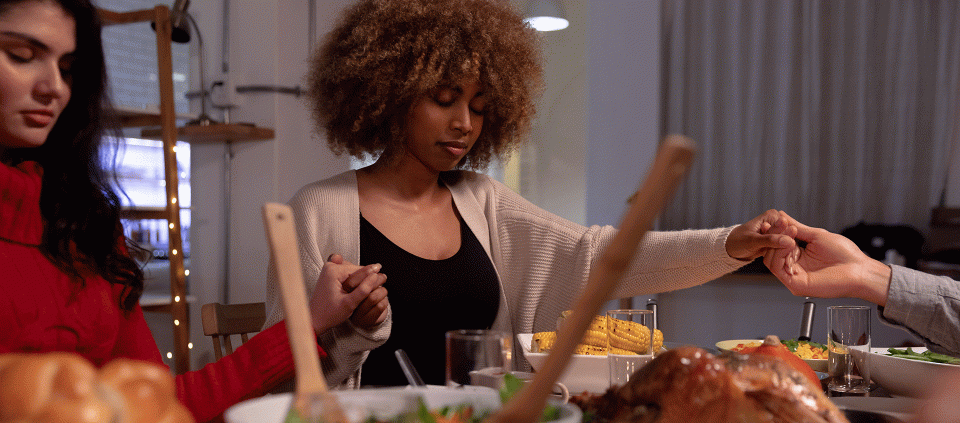Eight Mindful-Eating Tips for the Holidays

When faced with a holiday table laden with delicious dishes and enticing scents, many of us load up the plate and dig in, distracted by animated conversation or stressful relationships. Practicing mindful eating can help us focus on what our body really needs.
Lisa B. Nelson, MD, Director of Medical Education at Kripalu, describes mindful eating as “the practice of being present while we eat.” Sounds simple, right? But for most of us, it’s not as easy as it sounds, Lisa says. There are so many distractions—external and internal—that pull us away from the experience of just tasting and enjoying our food. So mindful eating is the practice of returning to the moment, tasting and savoring, breathing and resting, over and over.
Yoga teacher Sarahjoy Marsh concurs with this description—while noting other dimensions. “Mindful eating also includes becoming mindful, often through curiosity and kind self-observation, of one’s relationship to eating. Are we hurried, distracted, grateful, bored, or exquisitely interested in the act of eating? Are we eating because we are lonely, overwhelmed, exhausted, or anxious? Is it the crunch of the food that pulls us to it, or its sweetness? Perhaps it is the crispness or mushiness of the food that creates our desire for it. Creating a mindfulness practice about our relationship with eating is a helpful skill for supporting behavior change or intervening on behaviors that no longer serve us.”
“Often people are astonished at how much enjoyment they can get out of one bite,” says Kripalu nutritionist Annie B. Kay. “I remind guests to remember what the holidays are about—and to get as much sweetness from relationships during that time as they can.”
So, how do you become a more mindful eater? The practice begins even before you take a bite.
Check in. Take time to assess your body's needs. Are you eating just because it’s a habitual mealtime? How hungry are you? Are you craving something else, like emotional nourishment or solace that food won’t satiate? What will truly satisfy your craving? Are you rushing through a meal and not getting enough quantity or quality of nutrients? Bring this level of consciousness and focus into the kitchen as you decide what to eat and go about the process of preparation and cooking.
Clear a space—both emotionally and physically. Make time for your meal so you don’t feel rushed. Set an attractive place at the table, even if you’re eating alone. Clear away the clutter—mentally and literally—and create a clean, pleasant environment in which to enjoy your eating experience.
Eliminate distractions. Turn off the radio, television, and digital devices, and remove books, magazines, and newspapers, so that you can be in the moment and focus solely on savoring your meal.
Slow down and give thanks. Take a few breaths before you begin to eat. You can use these moments to bring yourself fully to the table, acknowledging your gratitude to the fertile earth, the sun, the plants, the farmers, and everything else involved in delivering this food to your table.
Engage all your senses. No matter what you’re eating, enjoying your food is a sensual experience. While taste is a primary element of the meal, also appreciate how it looks on your plate—its colors and composition—and its aroma. Think about the sounds it makes as you chew, and how it feels in your mouth—its texture and temperature. Consider the nutrients you’re receiving. Appreciate every aspect of what you’re eating before you reach for another bite.
Chew it over. Digestion begins with the act of chewing; saliva contains enzymes that chemically break down food even as your teeth break it down physically. The more you chew, the more efficiently you digest your food and absorb its nutrients. Moreover, because it can take up to 20 minutes for the brain to receive the satiety signal from the gut, the slower we eat, the less likely we are to overeat.
Put the fork down. Slow yourself down even further by placing your utensils on the table between bites—or try your hand at chopsticks. Break the habit of gulping down your food, both for better health and to remain conscious of the act of eating.
Exercise your skills. Try out these steps while eating something very simple—perhaps a few nuts that need to be shelled, or a piece of fruit that you need to peel. Applying all these concepts to a small, modest snack will help you refine your practice.
Sarahjoy suggests that, with practice, you’ll create a new hunger—for mindfulness itself. “Practice mindful moments throughout your day, every day, to build the muscle of your mind for mindfulness,” she says. “Do not wait for the ‘event’ of eating, or yoga, or meditation. Certainly bring mindfulness to those activities in your day, but drop in repeatedly and consistently and you’ll discover that mindfulness becomes both easier and prompted from within. You will begin to crave it more than distraction.”

